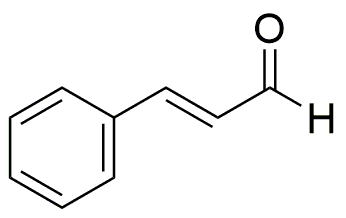trans-Cinnamaldehyde is widely utilized in research focused on:
- Flavoring and Fragrance Industry: Commonly used as a natural flavoring agent in food products and as a fragrance in cosmetics, it provides a warm, spicy aroma that enhances sensory appeal.
- Pharmaceutical Applications: Known for its antimicrobial and anti-inflammatory properties, it is explored in developing natural preservatives and therapeutic agents for various health conditions.
- Natural Insect Repellent: Its effectiveness in repelling insects makes it a valuable ingredient in eco-friendly pest control products, offering a safer alternative to synthetic chemicals.
- Research in Aromatherapy: Used in essential oils, it is studied for its potential mood-enhancing effects, contributing to wellness products aimed at stress relief and relaxation.
- Polymer Industry: As a monomer, it is investigated for creating bio-based polymers, promoting sustainability in materials science by reducing reliance on fossil fuels.
General Information
Properties
Safety and Regulations
Applications
trans-Cinnamaldehyde is widely utilized in research focused on:
- Flavoring and Fragrance Industry: Commonly used as a natural flavoring agent in food products and as a fragrance in cosmetics, it provides a warm, spicy aroma that enhances sensory appeal.
- Pharmaceutical Applications: Known for its antimicrobial and anti-inflammatory properties, it is explored in developing natural preservatives and therapeutic agents for various health conditions.
- Natural Insect Repellent: Its effectiveness in repelling insects makes it a valuable ingredient in eco-friendly pest control products, offering a safer alternative to synthetic chemicals.
- Research in Aromatherapy: Used in essential oils, it is studied for its potential mood-enhancing effects, contributing to wellness products aimed at stress relief and relaxation.
- Polymer Industry: As a monomer, it is investigated for creating bio-based polymers, promoting sustainability in materials science by reducing reliance on fossil fuels.
Documents
Safety Data Sheets (SDS)
The SDS provides comprehensive safety information on handling, storage, and disposal of the product.
Product Specification (PS)
The PS provides a comprehensive breakdown of the product’s properties, including chemical composition, physical state, purity, and storage requirements. It also details acceptable quality ranges and the product's intended applications.
Certificates of Analysis (COA)
Search for Certificates of Analysis (COA) by entering the products Lot Number. Lot and Batch Numbers can be found on a product’s label following the words ‘Lot’ or ‘Batch’.
*Catalog Number
*Lot Number
Certificates Of Origin (COO)
This COO confirms the country where the product was manufactured, and also details the materials and components used in it and whether it is derived from natural, synthetic, or other specific sources. This certificate may be required for customs, trade, and regulatory compliance.
*Catalog Number
*Lot Number
Safety Data Sheets (SDS)
The SDS provides comprehensive safety information on handling, storage, and disposal of the product.
DownloadProduct Specification (PS)
The PS provides a comprehensive breakdown of the product’s properties, including chemical composition, physical state, purity, and storage requirements. It also details acceptable quality ranges and the product's intended applications.
DownloadCertificates of Analysis (COA)
Search for Certificates of Analysis (COA) by entering the products Lot Number. Lot and Batch Numbers can be found on a product’s label following the words ‘Lot’ or ‘Batch’.
*Catalog Number
*Lot Number
Certificates Of Origin (COO)
This COO confirms the country where the product was manufactured, and also details the materials and components used in it and whether it is derived from natural, synthetic, or other specific sources. This certificate may be required for customs, trade, and regulatory compliance.


